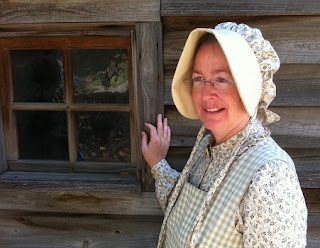 |
| Spinning on the Polonaise |
We also received more requests for photos than we've ever had before. People seemed drawn to the prairie dresses worn by both Cassandra and myself. Cassandra looks so natural in her grey dress. I just look really, really OLD in mine!! But they are comfortable - or as comfortable as anything can be in this heat! I insisted that Cassandra put on her bonnet whenever leaving the tent, as did I. Neither of us burned. Hey! Our ancestresses must have known what they were doing!
George got a proposal of marriage! A charming Czech lady came to the booth to watch us spin. She had a miniature spinning wheel - most likely a woodturning apprentice's "final exam" piece. It had been "fixed" by somebody who "knew all about spinning wheels." Needless to say, the poor thing couldn't spin. Honestly, it probably never did well, nor was it intended to. However, George went with her to look at the wheel. He was able to fix it for her and get it going again. As if that weren't enough, he noted the red dye on the decorated eggs the ladies had on display. They told him the dyestuff was cochineal, but they didn't know anything about it. He was able to fill them in on the story of cochineal. They were delighted!
 |
| Czech Decorated Egg |
I've known about the Polish version of the decorated eggs - Pysanki, I think it's called. I didn't know about the Czech eggs - Kraslice. Instead of drawing the design on the bare egg with wax, dyeing the egg so the shell takes the color everywhere except where the wax is, and then melting the wax off, Czech eggs are dyed a single color and then the design is scratched off to reveal the egg underneath. Cochineal is commonly used to get the strong, bright red color.
 |
| Fabric View of the Draft |
Why not? Well, it has to be crazy to use an untested draft at a demonstration with thousands of people watching. Okay, 99.9% of the thousands of people don't know anything about weaving, so you can get away with some things. However, your 19-year-old beginning weaver daughter needs to be able to weave this pattern and she's never woven overshot before. And so???
And so I did it. And it's beautiful! People were fascinated with it. Cassie was able to weave it with no problems after the first repeat or so.
 |
| Cassie at the loom |
When I took the runner off the loom, I was suprised to see that it was almost two feet longer than I thought it would be. Hmm... I'm still not sure how I did that. It's really too long, but it's so pretty. I think I'll try weaving it off in a finer thread. I have a large cone of natural 20/2 perle cotton and a large cone of 16/2 perle cotton coming. (Excitement!!)
 |
| The Finished Runner |
 |
| Overshot In Color Runner |
And in the meantime? Well, I'm making up another prairie dress and pinafore for myself and another shirt for George. When we do these multiday demonstrations, we need multiple outfits. And it's fun to have costume pieces to mix and match. I found an antique end-feed shuttle in an antique store this week. The wood is dry and the metal rusted, but I think it can be brought back into service and that will be fun! And on to weaving off the colorwork pillows I started before the Festival.

Lovely! What pattern do you use for your dress and apron. I haven't found one I like yet but yours looks so lovely!
ReplyDeleteBoth my daughter's dress and mine are Folkwear's Prairie Dress pattern. My daughter's apron is from the same pattern. Mine is a mish-mash of Butterick's 5509, view D and the Folkwear pattern. The Folkwear apron skirt wasn't full enough for the bodice of the Butterick pattern, but I made it work. When I make the next one, I'll add more width to the skirt apron pieces.
ReplyDelete